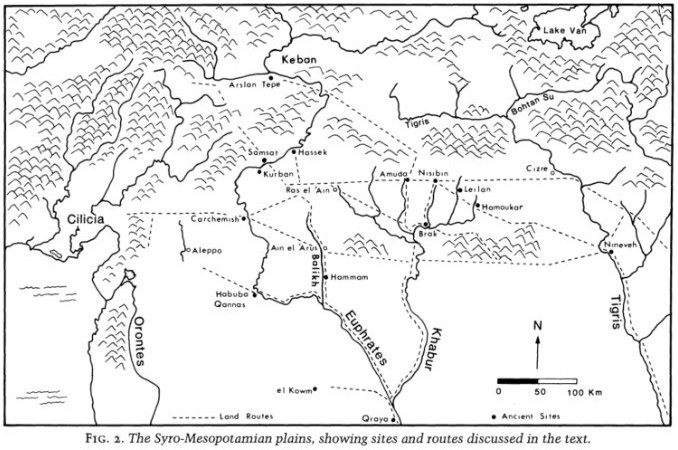HOME / Table of Contents = Civilizations - Cultures - Areas - Regions - Prehistory
Other Archaeological Sites / The Neolithic of the Levant (500 Page Book Online)

The Uruk Expansion: Cross Cultural Exchange in Early Mesopotamian Civilization
Guillermo Algaze in Current Anthropology Volume 30:5:1989 (571-608)
Excerpts and Definitions and Addendums:
ProofRead and Updated June 17th 2019

 Perched on a low terrace directly above the Euphrates floodplain some 17 kilometers north of the modern town of Meskene is the large flat site of Habuba Kabira and its acropolis Tell Qannas. Excavations there have revealed that an earlier settlement relatively modest in size and apparently short-lived as well was replaced by a well planned city with carefully laid-out streets and a sturdily built fortificaton wall with at least two gates. Directly to the southwest of the acropolis was an extended low mound contemporaneous with the settlemnt nearby but that does not appear to have been encompassed within the city walls. The scale of this settlement is impressive. The area within the city wall as preserved is about 10 hectares but when the contemporary settled area southwest of Tell Qannas is added to this the minimum size of the site comes to about 18 hectares. Moreover surface traces of Uruk pottery found across a band of land bordering the river north of the city suggest that it could have been significantly larger by as much as 40 hectares.
Perched on a low terrace directly above the Euphrates floodplain some 17 kilometers north of the modern town of Meskene is the large flat site of Habuba Kabira and its acropolis Tell Qannas. Excavations there have revealed that an earlier settlement relatively modest in size and apparently short-lived as well was replaced by a well planned city with carefully laid-out streets and a sturdily built fortificaton wall with at least two gates. Directly to the southwest of the acropolis was an extended low mound contemporaneous with the settlemnt nearby but that does not appear to have been encompassed within the city walls. The scale of this settlement is impressive. The area within the city wall as preserved is about 10 hectares but when the contemporary settled area southwest of Tell Qannas is added to this the minimum size of the site comes to about 18 hectares. Moreover surface traces of Uruk pottery found across a band of land bordering the river north of the city suggest that it could have been significantly larger by as much as 40 hectares.
This settlement was not isolated; it was surrounded by a cluster of smaller sites in which the Uruk material culture also prevailed. At least nine of these sites have been identified. It also appears certain that the planners and probably a substantial proportion of the inhabitants of Habuba Kabira/Tell Qannas city and its dependencies (satellites) were of southern Mesopotamian origin (intrusive) ...
The History of the Ancient Near East Electronic Compendium

